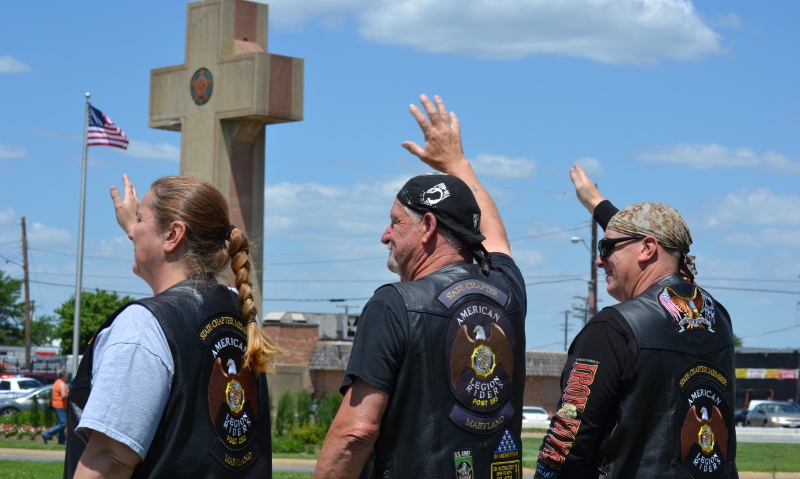
Saving the Bladensburg Peace Cross
More than 120 citizens, including a strong showing by American Legion Riders, staged a May 31 rally to save the Peace Cross monument in Bladensburg, Md., from being taken away. In February, a humanist group filed a lawsuit to remove the cross from its location on public land, claiming it violates the constitutional separation of church and state.
The 40-foot-high Peace Cross, which includes an American Legion emblem at its crux, is located at the intersection of Maryland Route 450 and U.S. Route 1. It was authorized through the Commissioners of Bladensburg to serve as a memorial for residents of Prince George's County who died while serving in the armed forces during World War I.
The monument's ground-breaking ceremony was held Sept. 28, 1919 – less than two weeks after The American Legion received its charter from Congress. According to the Washington Post, "Two thousand citizens of the county gathered for the exercises," where then-Secretary of the Navy Josephus Daniels "paid a high tribute to the heroes" who died during the war. In July 1925, the Peace Cross – with the names of 49 fallen heroes on a bronze tablet – was dedicated in a public ceremony.
Although the monument is undeniably in the shape of a Latin cross, three American Legion Riders at the rally from Post 293 in Waldorf, Md. – Bradford Lee, Sandra Linder andJeff Levesque – weren't buying the argument put forth by the American Humanist Association that the cross violates the separation between church and state.
What opponents of the cross want to do is simply wrong, Lee said. "It's a Peace Cross. It's a symbol for World War I veterans of P.G. County. It was not put there as a religious symbol. It's a cross – get over it."
Linder, a Navy veteran whose two grandfathers served in World War II, says the Peace Cross is part of her childhood; she grew up in a nearby neighborhood. She says people who want the cross moved are "inconsiderate and don't have patriotic spirit."
Levesque doesn't understand why the Peace Cross would offend some people. "It's a memorial," he said. "It's for our veterans. It's not for them. We don't take down their stuff – leave ours alone."
The Peace Cross is one of several monuments on public land across the country that have become targets of lawsuits filed by groups and individuals who claim that memorials to America's veterans and fallen servicemembers that include religious symbols are a violation of their constitutional rights; other cross-shaped monuments attacked by lawsuits include one in the Mojave Desert and another atop Mt. Soledad in San Diego.
Mark Beard, an Army veterans and sergeant-at-arms for American Legion Post 217 in College Park, Md., says he took part in the rally because the Peace Cross "represents sacrifice – it's our brothers that went before us that shed their blood for this country." He fears if the Bladensburg monument is removed, other cross-shaped memorials to America's fallen heroes are sure to follow, including the thousands of crosses at Arlington National Cemetery.
A call by anyone to remove the cross is "a slap in the face" to all veterans, Beard sajid. "Just because the memorial is in the shape of a cross, they want to dishonor our brothers from the past, and they want to tear down this memorial. As a veteran, I won't stand for it. And as an American, it just appalls me that this is even happening."
The American Legion's assistant Legislative director in Washington, Shaun Rieley, also attended the rally. He said The American Legion has filed a petition "to become a party in the lawsuit in order to defend the (Peace) Cross."
The U.S. Supreme Court, Rieley explained, held in its Salazar v. Buono ruling of April 2010 that the Latin cross, when used in the context of war memorials, "is not an explicitly religious symbol, that it can be understood as a general symbol of sacrifice and remembrance."
Writing for the majority in the Salazar case (decided by 5-4 vote) Justice Anthony Kennedy noted, "The goal of avoiding governmental endorsement [of religion] does not require eradication of all religious symbols in the public realm."
Rieley's article about the current attack on the Peace Cross, "Memorial Madness," was published May 26 in National Review Online.
